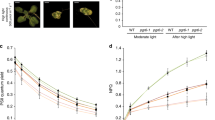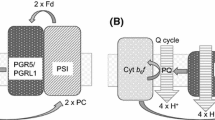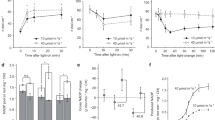Abstract
The proton motive force (PMF) across the chloroplast thylakoid membrane that is generated by electron transport during photosynthesis is the driving force for ATP synthesis in plants. The PMF mainly arises from the oxidation of water in photosystem II and from electron transfer within the cytochrome b6f complex. There are two electron transfer pathways related to PMF formation: linear electron flow and cyclic electron flow. Proton gradient regulation 5 (PGR5) is a major component of the cyclic electron flow pathway, and the Arabidopsis pgr5 mutant shows a substantial reduction in the PMF. How the PGR5-dependent cyclic electron flow contributes to ATP synthesis has not, however, been fully delineated. In this study, we monitored in vivo ATP levels in Arabidopsis chloroplasts in real time using a genetically encoded bioluminescence-based ATP indicator, Nano-lantern(ATP1). The increase in ATP in the chloroplast stroma of pgr5 leaves upon illumination with actinic light was significantly slower than in wild type, and the decrease in ATP levels when this illumination stopped was significantly faster in pgr5 leaves than in wild type. These results indicated that PGR5-dependent cyclic electron flow around photosystem I helps to sustain the rate of ATP synthesis, which is important for growth under fluctuating light conditions.



Similar content being viewed by others
References
Akerboom J, Carreras Calderón N, Tian L et al (2013) Genetically encoded calcium indicators for multi-color neural activity imaging and combination with optogenetics. Front Mol Neurosci 6:2
Allakhverdiev SI (2011) Recent progress in the studies of structure and function of photosystem II. J Photochem Photobiol B Biol 104:1–8
Allakhverdiev SI, Klimov VV, Carpentier R (1997) Evidence for the involvement of cyclic electron transport in the protection of photosystem II against photoinhibition: influence of a N new phenolic compound. Biochemistry 36:4149–4154
Allakhverdiev SI, Nishiyama Y, Takahashi S et al (2005) Systematic analysis of the relation of electron transport and ATP synthesis to the photodamage and repair of photosystem II in Synechocystis. Plant Physiol 137:263–273
Aro E-M, Virgin I, Andersson B (1993) Photoinhibition of Photosystem II. Inactivation, protein damage and turnover. Biochim Biophys Acta 1143:113–134
Avenson TJ, Cruz JA, Kanazawa A, Kramer DM (2005) Regulating the proton budget of higher plant photosynthesis. Proc Natl Acad Sci 102:9709–9713
Blankenship RE (2002) Molecular mechanisms of photosynthesis. Blackwell Science Ltd, Malden
Horikawa K, Yamada Y, Matsuda T et al (2010) Spontaneous network activity visualized by ultrasensitive Ca2+ indicators, yellow cameleon-Nano. Nat Methods 7:729–732
Huang W, Zhang S-B, Cao K-F (2010) Stimulation of cyclic electron flow during recovery after chilling-induced photoinhibition of PSII. Plant Cell Physiol 51:1922–1928
Huang W, Yang Y-J, Zhang S-B, Liu T (2018) Cyclic electron flow around photosystem I promotes ATP synthesis possibly helping the rapid repair of photodamaged photosystem II at low light. Front Plant Sci 9:239
Iwano M, Ito K, Fujii S et al (2015) Calcium signalling mediates self-incompatibility response in the Brassicaceae. Nat Plants 1:15128
Kawashima R, Sato R, Harada K, Masuda S (2017) Relative contributions of PGR5- and NDH-dependent photosystem I cyclic electron flow in the generation of a proton gradient in Arabidopsis chloroplasts. Planta 246:1045–1050
Koizumi H, Oshima Y (1993) Light environment and carbon gain of understory herbs associated with sunflecks in a warm temperate deciduous forest in Japan. Ecol Res 8:135–142
Kuroda H, Inagaki N, Satoh K (1992) The level of stromal ATP regulates translation of the D1 protein in isolated chloroplasts. Plant Cell Physiol 33:33–39
Mattoo AK, Hoffman-Falk H, Marder JB, Edelman M (1984) Regulation of protein metabolism: coupling of photosynthetic electron transport to in vivo degradation of the rapidly metabolized 32-kilodalton protein of the chloroplast membranes. Proc Natl Acad Sci 81:1380–1384
Miyawaki A, Griesbeck O, Heim R, Tsien RY (1999) Dynamic and quantitative Ca2+ measurements using improved cameleons. Proc Natl Acad Sci USA 96:2135–2140
Munekage Y, Hojo M, Meurer J et al (2002) PGR5 is involved in cyclic electron flow around photosystem I and is essential for photoprotection in Arabidopsis. Cell 110:361–371
Ohkura M, Sasaki T, Kobayashi C et al (2012) An improved genetically encoded red fluorescent Ca2+ indicator for detecting optically evoked action potentials. PLoS ONE 7:e39933
Pearcy RW (1990) Sunflecks and photosynthesis in plant canopies. Annu Rev Plant Physiol Plant Mol Biol 41:421–453
Ruban AV (2016) Nonphotochemical chlorophyll fluorescence quenching: mechanism and effectiveness in protecting plants from photodamage. Plant Physiol 170:1903–1916
Saito K, Nagai T (2015) Recent progress in luminescent proteins development. Curr Opin Chem Biol 27:46–51
Saito K, Chang Y-F, Horikawa K et al (2012) Luminescent proteins for high-speed single-cell and whole-body imaging. Nat Commun 3:1262
Shikanai T (2007) Cyclic electron transport around photosystem I: genetic approaches. Annu Rev Plant Biol 58:199–217
Shikanai T (2016) Regulatory network of proton motive force: contribution of cyclic electron transport around photosystem I. Photosynth Res 129:253–260
Shikanai T, Yamamoto H (2017) Contribution of cyclic and pseudo-cyclic electron transport to the formation of proton motive force in chloroplasts. Mol Plant 10:20–29
Smith WK, Berry ZC (2013) Sunflecks? Tree Physiol 33:233–237
Suorsa M, Rossi F, Tadini L et al (2016) PGR5-PGRL1-dependent cyclic electron transport modulates linear electron transport rate in Arabidopsis thaliana. Mol Plant 9:271–288
Suzuki K, Nagai T (2017) Recent progress in expanding the chemiluminescent toolbox for bioimaging. Curr Opin Biotechnol 48:135–141
Tikkanen M, Mekala NR, Aro E-M (2014) Photosystem II photoinhibition-repair cycle protects Photosystem I from irreversible damage. Biochim Biophys Acta - Bioenergy 1837:210–215
Vierling LA, Wessman CA (2000) Photosynthetically active radiation heterogeneity within a monodominant Congolese rain forest canopy. Agric For Meteorol 103:265–278
Way DA, Pearcy RW (2012) Sunflecks in trees and forests: from photosynthetic physiology to global change biology. Tree Physiol 32:1066–1081
Wu Y, Zheng F, Ma W et al (2011) Regulation of NAD(P)H dehydrogenase-dependent cyclic electron transport around PSI by NaHSO3 at low concentrations in tobacco chloroplasts. Plant Cell Physiol 52:1734–1743
Wu J, Liu L, Matsuda T et al (2013) Improved orange and red Ca2+ indicators and photophysical considerations for optogenetic applications. ACS Chem Neurosci 19:963–972
Zhang S, Scheller HV (2004) Photoinhibition of photosystem I at chilling temperature and subsequent recovery in Arabidopsis thaliana. Plant Cell Physiol 45:1595–1602
Zhao Y, Araki S, Wu J et al (2011) An expanded palette of genetically encoded Ca2+ indicators. Science 333:1888–1891
Author information
Authors and Affiliations
Corresponding author
Electronic supplementary material
Below is the link to the electronic supplementary material.
Rights and permissions
About this article
Cite this article
Sato, R., Kawashima, R., Trinh, M.D.L. et al. Significance of PGR5-dependent cyclic electron flow for optimizing the rate of ATP synthesis and consumption in Arabidopsis chloroplasts. Photosynth Res 139, 359–365 (2019). https://doi.org/10.1007/s11120-018-0533-9
Received:
Accepted:
Published:
Issue Date:
DOI: https://doi.org/10.1007/s11120-018-0533-9




